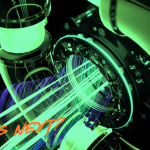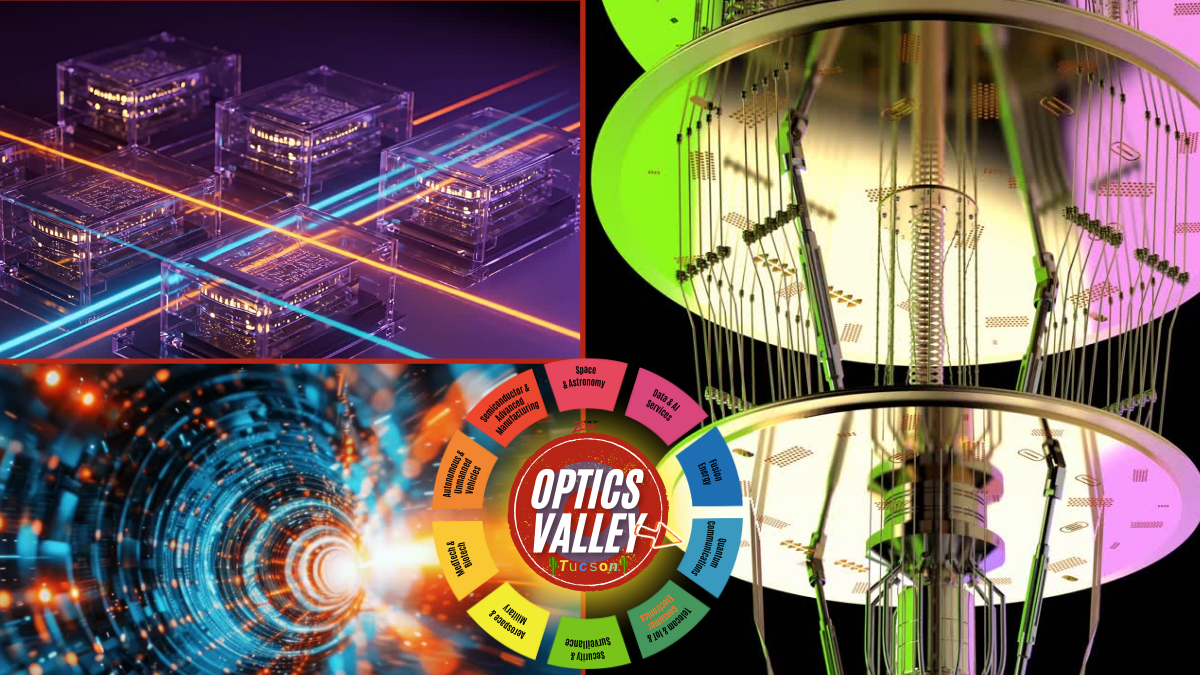Introducing Quantum Computing and Communications
Powered by Optics Valley – Part of a $1T global market
Co-Authors: Greg Pitz and Peter Mantas
Quantum computing and quantum communications are some of the most exciting areas in modern science. At their core is light, or more specifically, photons. Photons are light particles, central to how information can be stored, transmitted, and measured in quantum systems. The fields of optics and photonics give us the devices and techniques needed to create, move, and detect photons at the quantum level.
Without optics and photonics, there would be no way to build a quantum computer or communication network. This article explains the technologies and applications that make these systems work, and when they may become ready for large-scale use.
Photons as Qubits
Photons are one of the best candidates for qubits. Unlike electrons, they interact weakly with the environment, making them less likely to lose their fragile quantum state. They also move at the speed of light, making them ideal for communication between distant locations.
Using photons as qubits requires three core technologies:
- single-photon sources to produce one photon at a time,
- entangled photon pairs to create quantum links, and
- integrated photonic circuits to guide and control photons on a chip.
Creating Quantum Light
The first step is to create photons that can be used as qubits. Ordinary light sources, like lasers, emit many photons simultaneously, which is useless for quantum operations. Quantum systems need highly controlled sources that deliver either one photon at a time or pairs of entangled photons.
- Single-photon sources use technologies like quantum dots, color centers in diamond, or nanophotonic cavity QED (quantum electrodynamic) systems to produce photons on demand.
- Entangled photon sources rely on nonlinear optical processes in crystals or integrated waveguides to create pairs of photons whose states are linked no matter how far apart they travel.
These specialized light sources are the foundation of quantum computing and quantum communications.
Integrated Photonics for Quantum Circuits
Once photons are generated, they must be guided and manipulated to perform computations or transmit information. This is done with integrated photonics, optical circuits built on chips. Instead of carrying electrical currents, these chips carry light through waveguides, resonators, and interferometers.
Integrated photonics allows engineers to:
- Build quantum logic gates where photons interfere to perform operations.
- Design compact and scalable circuits that can handle many qubits at once.
- Use inverse design techniques to shape nanostructures that precisely control light.
The ultimate goal is to make photonic quantum processors manufactured at scale, similar to how silicon chips are produced for classical computers.
Detecting Single Photons
After photons have been used in a computation or sent through a communication channel, they must be detected. Detecting a single photon is extremely difficult because photons carry very little energy. Advanced detectors are required.
- Superconducting nanowire single-photon detectors (SNSPDs) are among the most powerful. They can detect photons with nearly 100% efficiency and very low error rates.
- Avalanche photodiodes (APDs) multiply the signal of an incoming photon so that it can be measured.
- Waveguide-integrated detectors place the sensor directly on the photonic circuit, reducing losses.
- Homodyne and heterodyne detection systems are used in continuous-variable quantum optics, where quantum states of light are measured in terms of their phase and amplitude.
These devices act as the “eyes” of quantum systems, making it possible to confirm quantum states and read the results.
Quantum Communications
One of the most practical applications of quantum photonics today is quantum communications, especially Quantum Key Distribution (QKD).
QKD allows two parties to share a secret encryption key using photons. If anyone interferes with the communication, the quantum state of the photons collapses, exposing the intrusion. This makes QKD an extremely secure way to protect information.
Key technologies include:
- Fiber-based QKD systems, which send photons through standard telecommunication fibers.
- Free-space QKD systems, which transmit photons directly through the atmosphere.
- Satellite-to-ground links, which extend QKD across thousands of kilometers.
- Quantum repeaters extend secure communication distance by swapping entanglement between nodes.
These systems are being tested and, in some cases, already deployed in financial networks and government communication systems.
Quantum Error Correction
Quantum states are fragile and can be easily disturbed by environmental noise. We need methods to protect and correct errors to make quantum computers practical.
In photonic systems, quantum error correction often involves encoding a single logical qubit into many photons. Using redundancy, the overall state can still be recovered even if some photons lose their information.
One prominent method is the KLM protocol, which proved that scalable quantum computing is possible using only linear optical components like beam splitters, phase shifters, and photon detectors. Modern approaches build on this foundation, aiming to create fault-tolerant photonic circuits.
Neuromorphic Photonic Systems
Another promising area is using light in neuromorphic computing, which mimics how the human brain processes information. In these systems, photons move through networks of optical devices that act like artificial neurons and synapses.
Photonic tensor cores can perform billions of operations per second with low energy use. These systems may not be quantum computers, but they are closely related and could work alongside quantum hardware to accelerate artificial intelligence and large-scale data tasks.
Projected Timeline to Operational Readiness
Quantum technologies are moving quickly, but they will arrive in stages. Based on current progress, the timeline looks like this:
- Near-Term (Now to 2027)
- Quantum Key Distribution is already working in pilot networks and financial institutions. Wider rollout across telecom networks is expected soon.
- Early photonic neural networks are moving from laboratory prototypes to specialized applications.
- Mid-Term (2028 to 2035)
- Photonic quantum processors with hundreds to thousands of logical qubits could be demonstrated.
- Quantum communication backbones linking major cities with secure channels may become operational.
- Long-Term (Beyond 2035)
- Large-scale fault-tolerant photonic quantum computers with millions of qubits could outperform classical supercomputers in real applications.
- A global quantum internet connecting continents and satellites may become a reality.
These milestones depend heavily on continued progress in optics and photonics, especially in photon sources, detectors, and error correction methods.
Why Optics and Photonics Are Essential
Every part of quantum computing and communications relies on optics and photonics:
- Photon sources provide the raw material for qubits.
- Integrated photonic circuits guide and process light for quantum operations.
- Detectors measure the outcomes with single-photon sensitivity.
- Quantum repeaters and networks extend communication across vast distances.
- Error correction systems keep fragile quantum states stable.
In short, optics and photonics are not just supporting technologies; they are the foundation that makes quantum computing and communications possible.
Looking Ahead
The journey toward practical quantum systems is just beginning. In the next decade, secure quantum communication networks will grow, photonic processors will become more powerful, and new hybrid systems will combine photonics with classical and quantum hardware.
The future of information technology may look very different, with photons carrying data and quantum states worldwide. The work in optics and photonics in Optics Valley and the UArizona Wyant College of Optical Sciences today sets the stage for that future.








